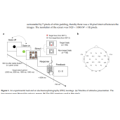Abstract
Searching familiar faces in the crowd may involve stimulus-driven attention by emotional significance, together with goal-directed attention due to task-relevant needs. The present study investigated the effect of familiarity on attentional processes by exploring eye fixation-related potentials (EFRPs) and eye gazes when humans searched for, among other distracting faces, either an acquaintance’s face or a newly-learned face. Task performance and gaze behavior were indistinguishable for identifying either faces. However, from the EFRP analysis, after a P300 component for successful search of target faces, we found greater deflections of right parietal late positive potentials in response to newly-learned faces than acquaintance’s faces, indicating more involvement of goal-directed attention in processing newly-learned faces. In addition, we found greater occipital negativity elicited by acquaintance’s faces, reflecting emotional responses to significant stimuli. These results may suggest that finding a familiar face in the crowd would involve lower goal-directed attention and elicit more emotional responses.
